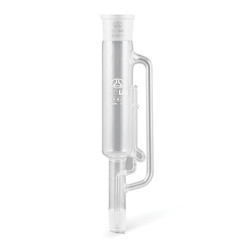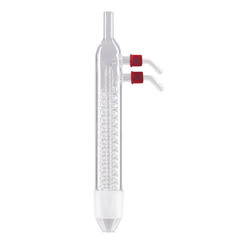You have no items in your shopping cart
Extraction
The Soxhlet attachment is an attachment for the continuous extraction of soluble ingredients from solids. It uses the drain siphon principle like a Pythagorean beaker to continuously drain the extract and extract the extraction material with pure solvent.
The solid to be extracted is filled into an extraction sleeve, which is usually made of cellulose, but also of glass fibres. A solvent is brought to a boil in the flask below the Soxhlet attachment, the vapors of which rise through the steam pipe and condense in the reflux condenser. The solvent then drips into the extraction thimble and there dissolves the desired substance from the solid. Due to the solubility of the component to be extracted in the substance to be extracted, a residual amount always remains, which is usually negligible with repeated extraction and a suitable solvent choice. The theoretical remaining amount can be calculated using Nernst's law of distribution.
As the solvent continues to drip, the liquid level in the Soxhlet attachment rises until it reaches the knee of the lateral siphon tube. The siphon effect that then occurs transports the extract back into the flask containing the solvent. Continuous boiling of the solvent in the flask and condensation on the condenser fills the extraction chamber over and over - the cycle repeats. The extraction sleeve must be higher than the overflow so that suspended particles of the extraction material do not enter the extract. Due to this constant leaching, also called percolation, with always pure solvent, the extract dissolved in the solvent increasingly accumulates in the flask. To isolate the extract, the Soxhlet apparatus is disassembled and the contents of the flask are concentrated by evaporating the solvent (e.g. on a rotary evaporator). The extract remains as a residue.
Using the Soxhlet device is recommended in plastics when the substance to be extracted is poorly soluble in the extractant, the same applies when natural substances have to be extracted from their sources. In the analysis, it is also used to determine the fat content of food and feed, as well as to determine the PAH concentration in contaminated soil. In the early 20th century it was used in childcare to determine the fat content of powdered milk, which is why it is used this time in children's literature, for example in Agnes Sapper.
You can buy this Soxhlet extractor and the Dimroth coolers at Laboratory discounter with a fast delivery for a friendly price.



